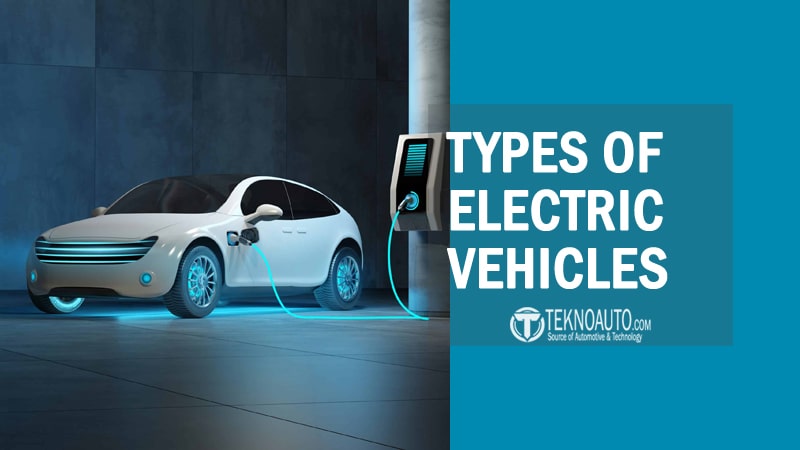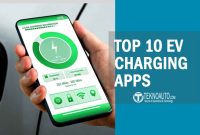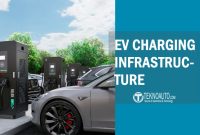The Types of Electric Vehicles on today’s roads are far more diverse than most drivers realize. What started with basic hybrids and early battery-powered cars has evolved into a full spectrum of EV types—including plug-in hybrids, hydrogen-powered models, and even ultra-compact city EVs. This growing diversity isn’t just technical—it reflects how electrification is adapting to different lifestyles, industries, and infrastructure challenges around the world.
As governments double down on zero-emission mandates and manufacturers invest billions into electrification, the question isn’t just whether to go electric—it’s which kind. For consumers, that decision isn’t always straightforward. A hybrid might seem familiar and practical. A battery electric car might promise lower running costs. Hydrogen-powered options offer quick refueling, but with strings attached.
Understanding the differences between EV types isn’t just helpful—it’s essential if you’re planning to make an informed choice or even just trying to keep up with the rapid shift in automotive technology. Because not all EVs are created equal, and knowing how they work can reveal a lot about where the future of driving is headed.
Understanding the Electric Vehicle Landscape
Electric Vehicles (EVs) didn’t just appear out of nowhere. In fact, the concept of electric mobility dates back to the 19th century—long before internal combustion engines became the default. Early electric carriages quietly rolled through cobblestone streets, celebrated for their simplicity and lack of smoke. But it wasn’t until recently, amid rising concerns about climate change, fossil fuel dependency, and urban pollution, that EVs re-entered the spotlight with real momentum.
What we’re seeing today is not just a technological shift, but a societal one. From city governments banning diesel cars to startups disrupting age-old automakers, the push for cleaner transportation is reshaping the global mobility landscape. As a result, the category of “electric vehicles” has become increasingly complex—no longer referring to one single type, but to a range of technologies each addressing different needs.
For consumers, this expansion can be overwhelming. Should you choose a hybrid to ease the transition from gasoline? Go fully electric with a BEV? Wait for the hydrogen infrastructure to mature? The answers depend not just on technical specs, but on how and where you drive, what your budget looks like, and how much you care about environmental impact.
Core Types of Electric Vehicles
That’s why understanding the core types of EVs—how they work, what they offer, and where they fall short—is the first real step toward making sense of this new era of transportation.
Battery Electric Vehicles (BEVs)
Battery Electric Vehicles (BEVs), represent the purest form of electric mobility. These vehicles operate entirely on electricity, drawing power from large battery packs that feed energy to one or more electric motors. There’s no gasoline engine, no tailpipe, and no emissions while driving. If you’re looking for a zero-compromise alternative to fossil fuel, this is where the conversation begins.
How BEVs Work
At the heart of every BEV lies a high-capacity lithium-ion battery, similar to what you’d find in a smartphone—only much larger and more sophisticated. This battery stores direct current (DC) electricity, which is converted into alternating current (AC) by an inverter, then used to power the vehicle’s electric motor. The system also includes regenerative braking, which captures energy during deceleration and sends it back to the battery, improving efficiency.
Charging a BEV is straightforward: plug it into a wall outlet, a Level 2 EV home charger, or a public fast-charging station. Depending on battery size and charger speed, a full charge can take anywhere from 30 minutes (with DC fast charging) to several hours (at home on a standard outlet).
Key Features and Advantages
BEVs are celebrated for their simplicity. With fewer moving parts than internal combustion engine (ICE) vehicles, they require less maintenance—no oil changes, spark plugs, or fuel filters. They also offer instant torque, delivering smooth, quiet acceleration that’s often quicker than many gas-powered cars.
Most importantly, BEVs produce zero tailpipe emissions. When charged from renewable energy sources, they offer a truly sustainable driving experience with a significantly lower carbon footprint.
Limitations and Challenges
The biggest concern for potential BEV owners is EV range anxiety—the fear of running out of battery before reaching a charger. While many modern BEVs now offer ranges exceeding 250–400 kilometers (150–250 miles) on a single charge, availability of fast-charging infrastructure can vary greatly by region.
Additionally, BEVs tend to have higher upfront costs, though tax incentives and long-term fuel savings often offset this over time.
Popular BEV Models
- Tesla Model 3 – One of the most popular electric sedans globally, known for performance and advanced software.
- Nissan Leaf – A pioneer in the segment, especially in urban markets.
- Chevrolet Bolt EV – Compact and affordable with a respectable range.
- Hyundai Ioniq 5 and Kia EV6 – Modern BEVs with fast charging and spacious interiors.
Hybrid Electric Vehicles (HEVs)

Hybrid Electric Vehicles (HEVs), were the first real bridge between traditional internal combustion engines and electric propulsion. Unlike BEVs, they don’t rely solely on electricity; instead, they combine a gasoline engine with an electric motor, working together to maximize fuel efficiency and reduce emissions. For many drivers, HEVs represent a low-risk entry into electrified transportation—familiar, efficient, and without the need to plug in.
How HEVs Work
In a typical HEV, both the gasoline engine and electric motor can drive the vehicle, either independently or in tandem. A small onboard battery—charged through regenerative braking and the engine itself—powers the electric motor during low-speed or stop-and-go driving. At higher speeds or when more power is needed, the gasoline engine takes over or assists.
What sets HEVs apart is that they don’t require external charging. The entire system is self-contained, relying on internal energy recapture to recharge the battery. This makes HEVs particularly attractive for drivers who want better fuel economy without changing their driving habits or investing in home charging equipment.
Key Features and Advantages
HEVs shine in city traffic, where the electric motor handles low-speed movement and stoplight crawls—conditions where conventional engines are most inefficient. The result is significantly improved fuel economy compared to standard gasoline vehicles.
Other advantages include:
- Lower emissions than conventional cars
- No range anxiety
- Affordable price points, especially for entry-level hybrids
- Familiar driving feel with quiet, smooth transitions between power sources
Limitations and Considerations
HEVs don’t offer the same environmental benefits as BEVs since they still burn gasoline and produce emissions. The electric-only range is extremely limited—typically just a few kilometers under ideal conditions. They also don’t benefit from public EV charging infrastructure since they’re not plug-in compatible.
Over time, as governments tighten emissions regulations and consumers lean more toward fully electric solutions, HEVs may serve increasingly as a transitional technology rather than a long-term answer.
Popular HEV Models
- Toyota Prius – Arguably the most iconic hybrid vehicle in history.
- Honda Insight – A compact hybrid with excellent fuel economy.
- Toyota Corolla Hybrid – Combines hybrid efficiency with conventional styling.
- Hyundai Elantra Hybrid – A newer entry offering value and efficiency.
Plug-in Hybrid Electric Vehicles (PHEVs)

Plug-in Hybrid Electric Vehicles (PHEVs), offer a unique blend of electric driving and traditional gasoline backup. They’re often seen as the middle ground between HEVs and BEVs—giving drivers a taste of all-electric mobility without completely severing ties to the gas pump. For many, this dual capability makes PHEVs an attractive option during the transition to fully electric transportation.
How PHEVs Work
Like HEVs, PHEVs use both an electric motor and a gasoline engine. The difference is that PHEVs come with a larger battery that can be charged by plugging into an external power source—either a standard home outlet or a public EV charging station. This allows the vehicle to run purely on electricity for a certain distance, typically between 25 to 80 kilometers (15 to 50 miles) depending on the model.
Once the battery is depleted, the gasoline engine kicks in automatically, allowing the vehicle to operate like a conventional hybrid. This seamless switch eliminates range anxiety and makes long-distance travel more convenient than in BEVs.
Key Features and Advantages
One of the standout features of PHEVs is flexibility. For daily commuting, many drivers find they rarely use any gasoline at all—charging overnight and using the electric motor alone for most short trips. On weekends or road trips, the engine extends the range without requiring long charging stops.
Key advantages include:
- All-electric driving for short distances
- No range anxiety for long trips
- Lower fuel consumption overall
- Eligible for EV tax credits or incentives in many regions
- Smooth, quiet operation in EV mode
Limitations and Considerations
While PHEVs are more efficient than HEVs, they’re also more complex. The dual powertrains increase cost, weight, and in some cases, maintenance needs. Drivers who don’t plug in regularly may see little benefit over a standard hybrid.
Environmental benefits also depend heavily on how the vehicle is used. A PHEV that’s never charged effectively becomes a heavy, expensive hybrid—still burning fuel and producing emissions.
Popular PHEV Models
- Ford Escape Plug-in Hybrid – A practical crossover with a usable EV range.
- Toyota RAV4 Prime – One of the most powerful and efficient PHEVs on the market.
- Volvo XC60 Recharge – Luxury PHEV with a focus on performance and sustainability.
- Hyundai Tucson Plug-in Hybrid – Combines tech-forward features with versatility.
Fuel Cell Electric Vehicles (FCEVs)
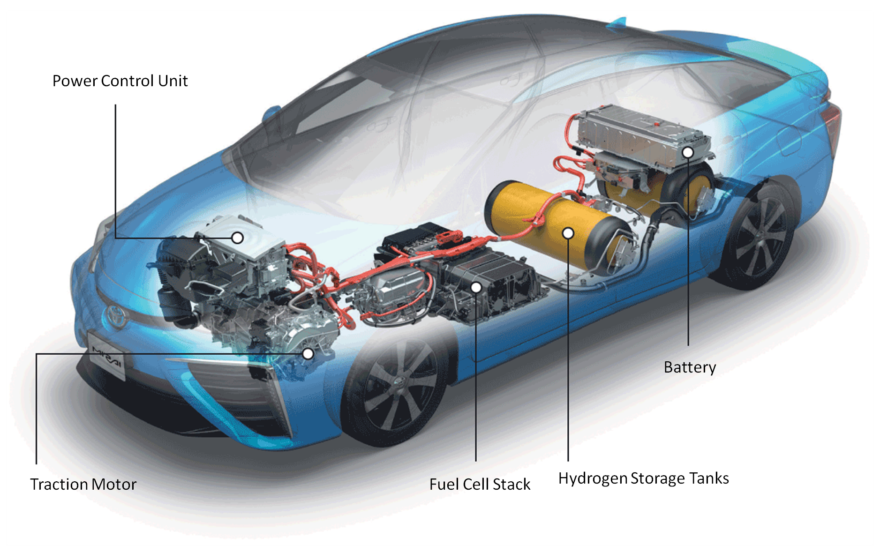
Fuel Cell Electric Vehicles (FCEVs), take a very different approach to electric mobility. Instead of drawing power from a battery that needs charging, these vehicles generate electricity onboard using hydrogen fuel and a chemical process called electrochemical conversion. The result is an electric driving experience—quiet, emission-free at the tailpipe—with the added benefit of fast refueling times similar to gasoline vehicles.
FCEVs are still a niche within the EV landscape, but they represent a promising alternative in the quest for zero-emission transportation, particularly for sectors where battery-based EVs face limitations.
How FCEVs Work
At the heart of an FCEV lies a hydrogen fuel cell stack, where compressed hydrogen gas is combined with oxygen from the air. Through a chemical reaction—without combustion—this process generates electricity, which powers the vehicle’s electric motor. The only by-product? Water vapor.
FCEVs store hydrogen in high-pressure tanks, and unlike BEVs, they don’t require hours of charging. Refueling takes roughly 3 to 5 minutes, making them especially appealing for fleet operations or long-distance travel.
Key Features and Advantages
The biggest selling point of FCEVs is fast refueling with long range. Many FCEVs can travel 500–650 kilometers (310–400 miles) on a full hydrogen tank—comparable to gasoline vehicles. Since the energy is generated as needed, there’s no heavy onboard battery like in BEVs.
Advantages include:
- Zero tailpipe emissions
- Quick refueling times
- Silent, smooth driving like other EVs
- Better scalability for larger vehicles (buses, trucks)
Limitations and Considerations
The biggest obstacle to FCEV adoption is infrastructure. Hydrogen refueling stations are limited to a few regions (primarily California, Japan, South Korea, and parts of Europe), making FCEVs impractical for most drivers.
Other challenges:
- High vehicle and hydrogen production costs
- Hydrogen is less energy-efficient compared to battery electricity
- Fewer model options available
- Hydrogen production may not always be green (depends on source)
Popular FCEV Models
- Toyota Mirai – The most widely recognized FCEV, known for its futuristic design and comfort.
- Hyundai NEXO – A fuel-cell SUV with solid range and practicality.
- Honda Clarity Fuel Cell – Previously available in select markets, focused on urban hydrogen corridors.
Extended-Range Electric Vehicles (EREVs)

Extended-Range Electric Vehicles, or EREVs, are a rare and somewhat transitional form of electric mobility that aim to deliver the best of both electric and combustion technologies—without some of the compromises of a traditional plug-in hybrid. While often grouped with PHEVs, EREVs are technically distinct in how they use their gasoline engine: not to drive the wheels, but solely to generate electricity when the battery is depleted.
This subtle difference changes both how the vehicle behaves and how it’s perceived in the larger conversation around EVs.
How EREVs Work
An EREV operates as a pure electric vehicle for the first part of a journey, drawing energy exclusively from its battery. Once the battery is empty, a small gasoline-powered generator starts up—not to power the wheels directly, but to recharge the battery or supply electricity to the motor. This allows the vehicle to continue driving without a charging stop, but still uses the electric motor for propulsion at all times.
Because the combustion engine never drives the wheels, the driving experience remains smooth and consistent, much like a BEV.
Key Features and Advantages
The clearest advantage of EREVs is electric-first operation with a reliable gasoline backup that preserves the driving feel of a fully electric vehicle. They’re ideal for drivers who want to minimize fuel use but don’t want to worry about range or charging availability.
Key benefits include:
- Consistent electric drive feel
- Full daily commuting possible without using fuel
- Extended driving range for long trips
- No “transition” between EV Powertrains—only one propulsion system
Limitations and Considerations
EREVs never gained the same popularity as BEVs or PHEVs, mainly due to market complexity and cost. The need for two systems (battery + generator) adds weight and expense, and few manufacturers have committed to producing them at scale.
They’re also often misunderstood, with consumers mistaking them for standard hybrids or questioning the need for such a specific configuration.
Notable EREV Examples
- Chevrolet Volt – The most iconic EREV, often mistaken for a PHEV but designed to use the gas engine as a generator only.
- BMW i3 REx – A compact BEV with a small optional gasoline engine for emergency range extension.
Both vehicles have since been discontinued, but they played an important role in bridging the gap between early EV adopters and today’s mainstream electrification.
Mild Hybrid Electric Vehicles (MHEVs)
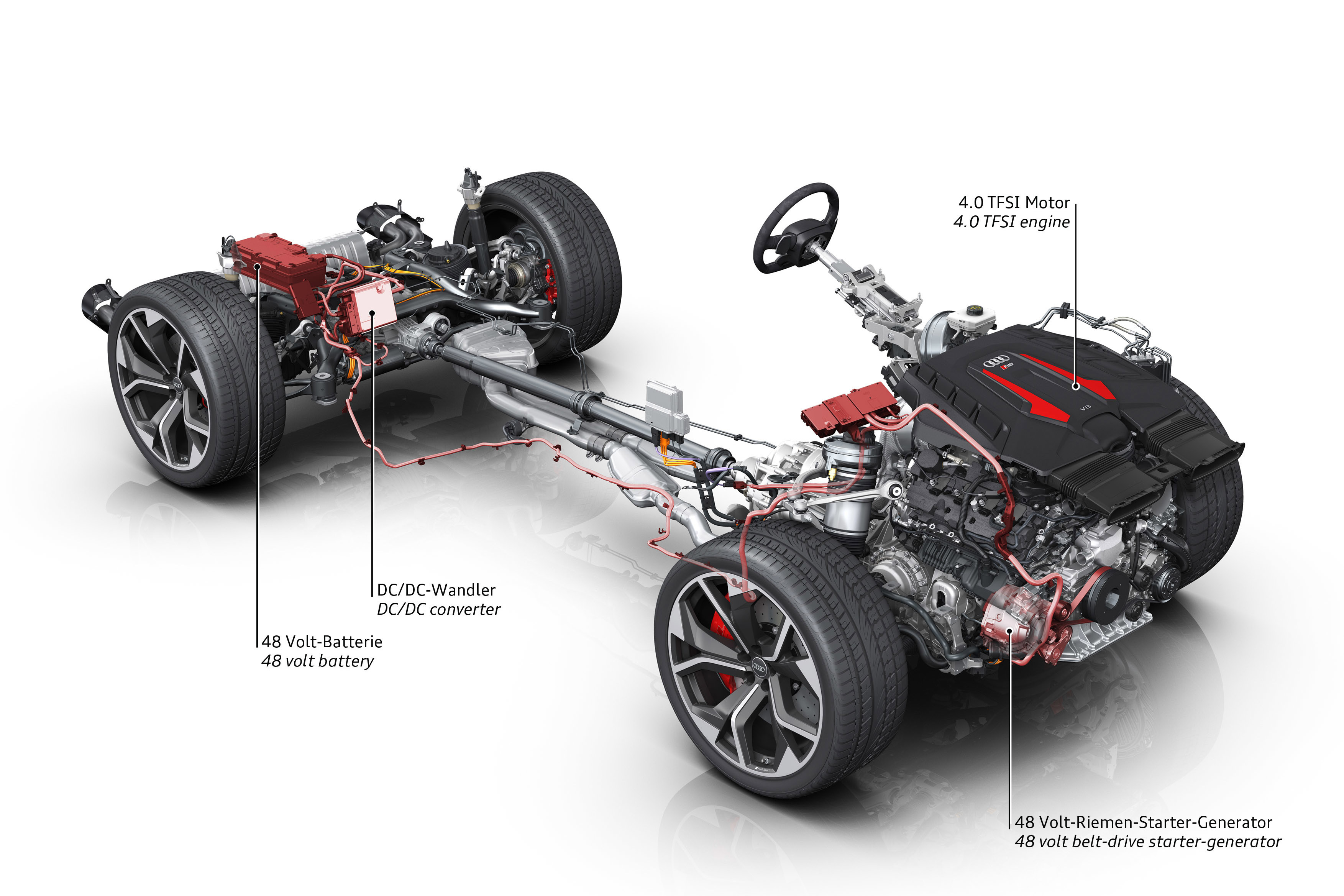
Mild Hybrid Electric Vehicles, or MHEVs, are a subtler form of vehicle electrification—designed not to replace the combustion engine, but to support it. Unlike full hybrids or plug-in models, MHEVs cannot drive on electricity alone. Instead, they use a small electric motor and battery to assist the gasoline engine during acceleration, idling, and stop-start conditions, improving overall efficiency without changing the driving experience.
MHEVs are often marketed as a practical efficiency upgrade rather than a true electric alternative.
How MHEVs Work
MHEVs typically feature a 48-volt electrical system (as opposed to the standard 12V in conventional cars) along with a belt-integrated starter generator (BSG). This system allows the engine to shut off when coasting or stopped, restart quickly, and receive a power boost when needed—reducing engine workload and fuel consumption.
The mild hybrid system recharges itself through regenerative braking and doesn’t require external charging.
Key Features and Advantages
What makes MHEVs attractive is their simplicity and cost-effectiveness. They deliver measurable efficiency gains without major design overhauls, making them easy for automakers to implement across various models—and for consumers to adopt without lifestyle changes.
Advantages include:
- Better fuel economy than standard ICE vehicles
- Smoother engine starts and acceleration
- Lower emissions and improved idle-stop behavior
- No charging infrastructure needed
- Typically more affordable than HEVs or PHEVs
Limitations and Considerations
Since MHEVs can’t operate independently on electric power, their environmental and fuel-saving benefits are more modest. The performance improvements are subtle, and they still rely entirely on fossil fuel for propulsion.
They’re best viewed as a transitional technology—improving efficiency without fully embracing electrification.
Popular MHEV Models
- Audi A6/A7 48V systems – Luxury sedans using mild hybrid tech for smoother performance.
- Hyundai Tucson MHEV – Combines affordability with mild efficiency gains.
- Suzuki Swift Hybrid (Mild) – Popular in some markets as a compact, fuel-efficient option.
- Ford Puma EcoBoost Hybrid – Small crossover with a 48V boost system.
Emerging and Specialized EV Types
Not every electric vehicle fits neatly into the core categories like BEVs, HEVs, or PHEVs. As the EV ecosystem evolves, so do the demands of drivers, cities, and industries—giving rise to a growing class of specialized and emerging electric vehicles. These aren’t one-size-fits-all machines. They’re purpose-built solutions, engineered for specific environments, tasks, or lifestyle needs.
From ultra-compact cars designed for narrow urban streets, to heavy-duty electric trucks and scooters zipping through alleys, this segment reflects the creative frontier of electrification—where innovation tends to move faster than regulation, and practicality often trumps convention.
Micro EVs and City Cars

As urban spaces become more congested and environmental concerns grow louder, automakers are rethinking what personal transportation should look like in dense cities. Enter micro EVs—compact, lightweight electric vehicles designed for short-range, low-speed commuting. These aren’t your typical family cars; they’re purpose-built for navigating narrow streets, tight parking, and short errands in the most efficient way possible.
City EVs prioritize practicality over power, and their minimalist design reflects that.
Micro EVs (also known as quadricycles in Europe) are typically two-seaters or three-wheelers with limited top speeds and smaller batteries—often with a range between 50 to 150 kilometers (30 to 90 miles). Many models lack traditional features like airbags, infotainment systems, or even a full climate control system. But what they lack in luxury, they make up for in affordability, agility, and energy efficiency.
They are often subject to different safety and licensing regulations, depending on the country.
In cities where car ownership is becoming less practical and public transportation is saturated, micro EVs offer a compelling alternative. They’re cheap to operate, easy to park, and require minimal maintenance. Some cities even allow them in bike lanes or limited-access zones where regular cars are banned.
They also align well with last-mile delivery services, where electric cargo scooters and ultra-compact vans are already proving valuable.
Examples of Micro EVs
- Renault Twizy – A narrow, two-seat urban EV with futuristic styling and strong adoption in European cities.
- Citroën Ami – An ultra-affordable electric quadricycle aimed at young drivers and urban dwellers.
- Smart EQ ForTwo – A premium micro EV with better comfort and range than most ultra-compacts.
- Wuling Hongguang Mini EV – China’s best-selling micro EV, praised for its price and practicality.
Electric Motorcycles, Scooters, and E-bikes
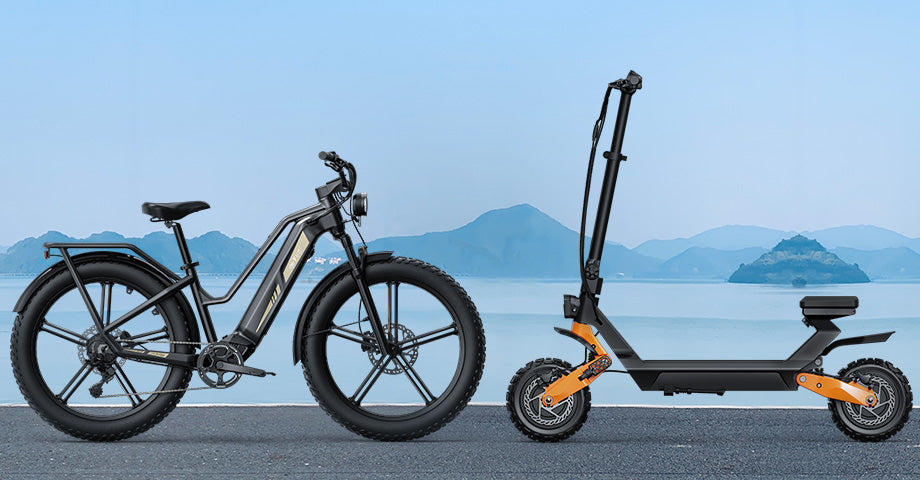
While much of the attention in the EV world goes to cars and trucks, two-wheeled electric vehicles have quietly exploded in popularity—especially in regions where motorcycles and scooters are already dominant. Whether it’s a commuter avoiding traffic in Jakarta, a delivery rider in Delhi, or a college student cruising campus in California, electric two-wheelers are reshaping personal transport on a more intimate scale.
These vehicles combine agility, affordability, and sustainability in ways that larger EVs often can’t.
This segment covers a wide range of vehicle types, including:
- Electric Motorcycles – High-speed, road-legal bikes with full electric drivetrains, often used for sport or highway commuting.
- Electric Scooters – Low-speed, compact vehicles ideal for urban use.
- E-bikes (Electric Bicycles) – Pedal-assisted or throttle-powered bikes popular for short-distance travel and delivery services.
Some models are designed for private ownership, while others are optimized for shared mobility platforms and rental services.
Electric two-wheelers are often the first entry point into electrified transport, particularly in countries where motorcycle culture is well-established. Their small size means lower battery requirements, faster charging, and far lower production costs—making them ideal for high-volume deployment.
They also generate minimal noise and emissions, helping to address air and sound pollution in urban environments.
A notable innovation in this space is battery swapping, where users exchange depleted batteries for fully charged ones at dedicated stations—dramatically reducing downtime. Companies like Gogoro (Taiwan) and Ather Energy (India) are pioneering this model.
This infrastructure is more scalable in crowded cities than traditional charging stations for cars, and has already gained traction in Asia.
Popular Models and Platforms
- Zero SR/F – A performance-oriented electric motorcycle with highway capabilities.
- NIU NQi Series – Widely used smart scooters for urban mobility.
- Gogoro Smartscooter – A leader in the battery swapping ecosystem.
- Rad Power Bikes – High-quality e-bikes popular in the U.S. for urban and recreational use.
- Yadea, Ola Electric, Ather 450X – Rising players in Asia’s booming two-wheeler EV market.
Electric Commercial Vehicles

While most conversations about EVs focus on passenger cars, the electrification of commercial vehicles could have an even greater impact on global emissions and urban air quality. From delivery vans to buses and heavy-duty trucks, electric commercial vehicles are transforming logistics, public transportation, and fleet operations in profound ways.
These aren’t just cleaner alternatives—they’re also becoming smarter, quieter, and more cost-effective in the long run.
Categories of Commercial EVs
Electric commercial vehicles span a wide spectrum of applications, including:
- Light-Duty Delivery Vans – For last-mile logistics in urban environments (e.g., Amazon, DHL).
- Medium-Duty Utility Trucks – Used by municipalities, trades, or regional freight services.
- Heavy-Duty Trucks – Long-haul freight vehicles, still in early-stage development.
- Electric Buses (E-buses) – Public transportation for cities and school systems.
- Electric Cargo Bikes & Compact Delivery Pods – Used in hyperlocal delivery networks.
Each of these categories has its own set of performance requirements—range, payload, duty cycle—that shape the design and technology used.
The transportation sector is one of the largest contributors to greenhouse gas emissions, and commercial fleets account for a significant portion of that. Electrifying delivery vans, buses, and trucks not only cuts emissions but also reduces noise pollution, operating costs, and maintenance overhead.
For urban areas especially, electric delivery vehicles help meet sustainability targets while improving air quality in dense neighborhoods.
Despite clear benefits, commercial EV adoption faces several hurdles:
- High upfront costs (though offset by long-term savings)
- Charging infrastructure for large fleets
- Limited range for heavier vehicles
- Long charging times vs diesel refueling
- Weight constraints affecting payload capacity
However, advancements in battery density, megawatt charging systems, and fleet management software are helping to close these gaps quickly.
Notable Examples
- Rivian EDV (Electric Delivery Van) – Custom-built for Amazon’s logistics fleet.
- Ford E-Transit – A versatile electric van designed for commercial applications.
- Volvo VNR Electric – A medium-duty electric truck used in regional haulage.
- BYD Electric Buses – Widely adopted across Asia, Europe, and North America.
- Arrival Van & Bus – Modular EVs targeting urban fleet applications.
Electric commercial vehicles are no longer experimental. In many regions, they’re already proving their value on the road, in warehouses, and at school gates.
Light-Duty vs Heavy-Duty EVs: How They’re Designed Differently
The term electric vehicle often brings to mind compact sedans or city hatchbacks, but the reality is far broader. EVs now span from small commuter cars to massive freight trucks—and their design considerations couldn’t be more different. Understanding the contrast between light-duty and heavy-duty electric vehicles helps clarify how electrification is unfolding across all layers of the transportation sector.
Light-Duty EVs
Light-duty electric vehicles include most personal-use passenger cars, crossovers, small SUVs, and some delivery vans. These vehicles typically:
- Use lithium-ion batteries
- Have ranges between 200–500 km per charge
- Emphasize efficiency, affordability, and daily usability
- Are designed with aerodynamics and weight as key priorities
- Can be charged at home or standard public charging stations
Because they carry lighter loads and operate in predictable use cycles, light-duty EVs have become the most mature and accessible segment of the EV market.
Heavy-Duty EVs
Heavy-duty EVs include electric buses, trucks, semis, and industrial transporters—vehicles designed for commercial or infrastructure-heavy use. These vehicles face different engineering challenges:
- Require larger battery packs (often 300 kWh+)
- Operate under heavier payloads and over longer distances
- Need access to high-voltage charging infrastructure or dedicated fleet depots
- Prioritize durability, cooling systems, torque, and braking regeneration
- Must balance range with cargo capacity and regulatory weight limits
To offset charging times, some heavy-duty EVs are beginning to adopt megawatt charging systems (MCS), still in early development, to reduce downtime during logistics operations.
Design Trade-offs and Industry Trends
Heavy-duty EVs generally have higher upfront costs and longer development cycles, but they also offer larger carbon reduction per vehicle—making them a high-impact target for government incentives and fleet transitions. Meanwhile, light-duty EVs remain the entry point for mass-market consumers, with innovations in this segment often paving the way for features that scale upward.
As battery technology improves and infrastructure expands, the line between light- and heavy-duty EV capabilities will continue to blur—but their core differences in design, purpose, and performance will remain fundamental to how electrification scales globally.
Comparing Different EV Types
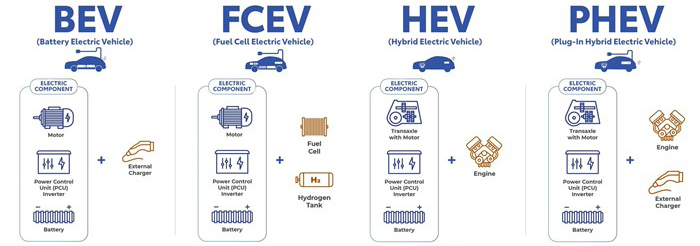
As the number of electric vehicle options continues to grow, so does the complexity of choosing between them. No single EV type is perfect for every driver or use case—each has its own strengths, weaknesses, and ideal scenarios. Understanding how they compare side by side can help buyers, fleet managers, and policy makers make informed decisions based not just on specs, but on context.
In this section, we’ll break down the most important differences between EV types, outline their practical pros and cons, and provide a guide to help match the right vehicle type with specific needs.
Comparison Table: Key Differences Between EV Types
The table below offers a quick reference across the core characteristics of BEVs, HEVs, PHEVs, FCEVs, EREVs, and MHEVs.
| EV Type | Primary Power Source | Electric-Only Range | Refueling/Charging Time | Tailpipe Emissions | Requires Plug-In? |
|---|---|---|---|---|---|
| BEV | Battery only | 200–500 km | 30 mins – 12 hours | None | Yes |
| HEV | Gas + electric motor | Very limited | None (self-charging) | Reduced (vs gas) | No |
| PHEV | Battery + gas engine | 25–80 km | 1.5–5 hours (Level 2) | Low (if charged) | Yes |
| FCEV | Hydrogen fuel cell | 400–650 km | ~5 minutes (hydrogen) | None | No (hydrogen refuel) |
| EREV | Battery + range extender | 50–80 km (battery), unlimited (gas) | ~4 hours + gas refill | Low (depends on usage) | Yes |
| MHEV | Gas + electric assist | None | None (self-charging) | Slightly reduced | No |
Pros and Cons of Each EV Type
Each EV type presents a different trade-off depending on usage, infrastructure, and user preferences:
| EV Type | Best For | Not Ideal For |
|---|---|---|
| BEV | Eco-conscious drivers, short-to-medium daily commutes, access to home charging | Long-distance drivers without access to reliable charging infrastructure |
| HEV | Drivers who want fuel savings without changing habits | Those seeking zero-emission transport |
| PHEV | Commuters who can charge regularly but want long-distance capability | Drivers who rarely plug in (miss the full benefit) |
| FCEV | Quick refueling, longer trips, fleet use in hydrogen-supported areas | Regions without hydrogen infrastructure |
| EREV | Drivers who want electric drive quality without range concerns | High-mileage users who never charge (inefficient use case) |
| MHEV | Budget-conscious drivers wanting incremental efficiency | Those expecting meaningful electric performance or electric-only driving |
Which EV Type Is Right for You?
Choosing the right EV type involves considering several factors:
- Driving habits: Do you mostly take short trips around town, or do you regularly drive long distances?
- Access to charging or hydrogen infrastructure: Can you charge at home or work? Are there public chargers nearby? Any hydrogen stations?
- Environmental priorities: Are you aiming for zero emissions, or just want to reduce fuel usage?
- Budget and incentives: Do you qualify for tax credits? Are you comfortable with higher upfront costs for lower running expenses?
- Ownership style: Do you prefer simplicity and fewer components (like a BEV), or do you value backup options (like PHEV/EREV)?
By thinking beyond the label and focusing on how each EV type fits real-world needs, you can make an informed decision that aligns with your lifestyle, values, and expectations.
The Future of Electric Mobility

The road to electrification is no longer a matter of if, but how fast. Governments, manufacturers, and consumers are all accelerating the transition—driven by environmental urgency, technological breakthroughs, and shifting public expectations. What once seemed like a niche or luxury trend has now become the central focus of the global auto industry.
Yet the journey is far from over.
Technological Innovation
Battery technology continues to evolve, with breakthroughs in solid-state batteries, faster charging, and longer range on the horizon. Companies are investing heavily in lighter materials, modular platforms, and software-defined vehicles that will redefine not just how we drive, but how we interact with our vehicles.
At the same time, hydrogen fuel cells, wireless charging, and solar integration are being explored as complementary or alternative solutions—each with unique potential depending on geography, infrastructure, and use case.
Policy and Regulation
More than 20 countries and dozens of major cities have already announced plans to phase out internal combustion engines, some as early as 2030. Stricter emissions regulations, EV purchase incentives, and massive investments in charging networks are reshaping the global automotive landscape.
This isn’t just a technological shift—it’s a regulatory one, too.
Ecosystem Growth
The EV revolution goes far beyond vehicles. It involves:
- Grid modernization to handle demand surges
- Renewable energy integration
- Second-life battery reuse
- Vehicle-to-grid (V2G) systems that let EVs return power to the grid
- EV-specific insurance, financing, and fleet logistics
The growth of electric mobility is creating new industries, redefining supply chains, and requiring a fresh look at how transportation fits into energy and urban planning.
Consumer-Centered Design
Perhaps most exciting is that the next wave of EVs won’t just be cleaner—they’ll be smarter, safer, and more tailored to individual lifestyles. From customizable UIs to AI-assisted driving, EVs are becoming digital products as much as mechanical ones.
As range anxiety fades, charging becomes more convenient, and total cost of ownership continues to fall, electric vehicles are poised to become the default, not the exception.
Conclusion
Electric vehicles are no longer confined to a single definition or design. From silent city cars and high-performance BEVs to hybrid crossovers, hydrogen-powered sedans, and electric delivery trucks, the world of EVs is more diverse—and more accessible—than ever before. Each type brings its own set of advantages, limitations, and use cases, reflecting the complexity of global mobility needs.
For consumers, this means greater choice and a better chance of finding an EV that fits seamlessly into their daily life. For policymakers and manufacturers, it means creating flexible infrastructure and smarter regulations that support a broad ecosystem of electric transport—not just one-size-fits-all solutions.
The transition to electric mobility is not just about eliminating emissions. It’s about rethinking how we move, what we prioritize, and how technology can serve both people and the planet. As the EV landscape continues to expand, understanding the different types of electric vehicles is the first step toward making decisions that are both informed and impactful.
Frequently Asked Questions (FAQs) About Types of Electric Vehicles
What are the main types of electric vehicles (EVs)?
The main types include Battery Electric Vehicles (BEVs), Hybrid Electric Vehicles (HEVs), Plug-in Hybrid Electric Vehicles (PHEVs), Fuel Cell Electric Vehicles (FCEVs), Extended-Range Electric Vehicles (EREVs), and Mild Hybrid Electric Vehicles (MHEVs).
Which type of EV is best for city driving?
BEVs and PHEVs are excellent for city use, especially models with compact designs and regenerative braking. Micro EVs and electric scooters are also popular in dense urban environments.
What is the difference between BEV and PHEV?
A BEV runs solely on electric power and must be charged via an external source. A PHEV has both a battery and a gasoline engine—it can drive on electricity alone for short distances but switches to gas when the battery depletes.
Are hybrid vehicles considered electric?
Yes, hybrid vehicles use both an electric motor and a gasoline engine. However, only plug-in hybrids (PHEVs) and some extended-range EVs (EREVs) allow for meaningful electric-only driving.
How long does it take to charge an EV?
Charging times vary by EV type and charger level. BEVs can take 30 minutes to 12 hours depending on battery size and charger power. PHEVs charge faster due to smaller batteries. FCEVs refuel in about 5 minutes with hydrogen.

